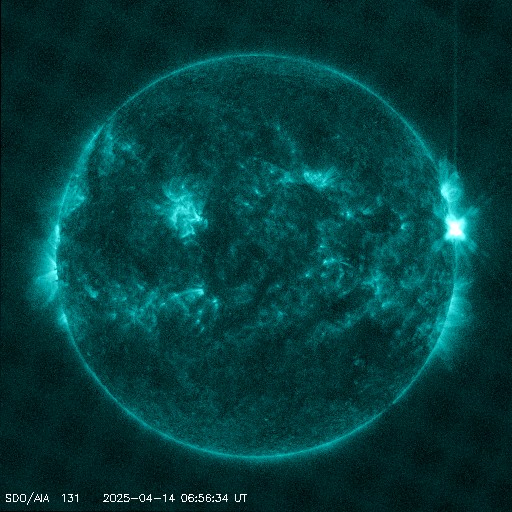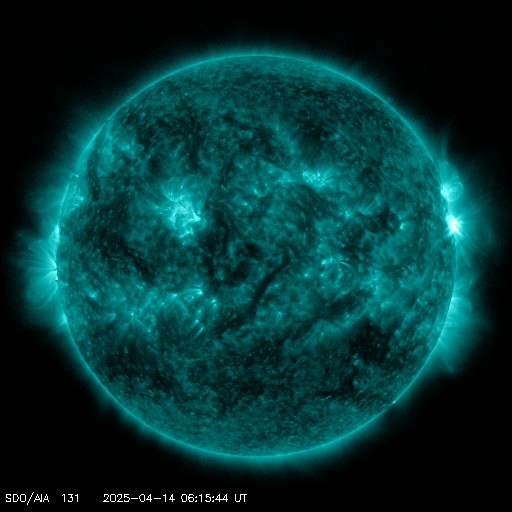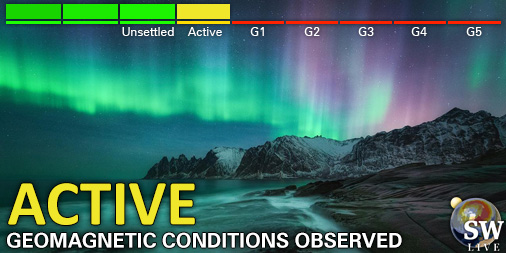Viewing archive of Saturday, 8 May 2010
Solar activity report
Any mentioned solar flare in this report has a scaling factor applied by the Space Weather Prediction Center (SWPC). Because of the SWPC scaling factor, solar flares are reported as 42% smaller than for the science quality data. The scaling factor has been removed from our archived solar flare data to reflect the true physical units.
Report of Solar-Geophysical Activity 2010 May 08 2201 UTCPrepared by the NOAA © SWPC and processed by SpaceWeatherLive.com
Joint USAF/NOAA Report of Solar and Geophysical Activity
SDF Number 128 Issued at 2200Z on 08 May 2010IA. Analysis of Solar Active Regions and Activity from 07-2100Z to 08-2100Z
Solar activity remained at low levels. Region 1069
(N41W78) produced isolated C-class flares as it approached the west
limb. The largest of these was a C9/1f at 08/0459Z associated with
radio bursts at 245 MHz and 410 MHz. New Region 1071 (S20W42), a
small A-type spot, was numbered. No Earth-directed CMEs were
observed during the period.
IB. Solar Activity Forecast
Solar activity is expected to be low
on day 1 (09 May) with a chance for isolated C-class flares from
Region 1069. Activity is expected to decrease to very low levels
during days 2 - 3 (10 - 11 May) due to the departure of Region 1069
early on 10 May.
IIA. Geophysical Activity Summary 07-2100Z to 08-2100Z
Geomagnetic field activity was at mostly quiet levels. ACE solar wind
measurements indicated Earth remained within a gradually subsiding
coronal hole high-speed stream. Solar wind velocities decreased from
518 to 437 km/sec during the period. The greater than 2 MeV electron
flux at geosynchronous orbit reached high levels during the period.
IIB. Geophysical Activity Forecast
Geomagnetic field activity is
expected to be at quiet to unsettled levels during days 1 - 2 (09 -
10 May) with a slight chance for active levels. Field activity is
expected to increase to unsettled levels on day 3 (11 May) with a
chance for active levels due a recurrent co-rotating interaction
region/coronal-hole high-speed stream.
III. Event Probabilities 09 May to 11 May
| Class M | 10% | 01% | 01% |
| Class X | 01% | 01% | 01% |
| Proton | 01% | 01% | 01% |
| PCAF | green | ||
IV. Penticton 10.7 cm Flux
Observed 08 May 079 Predicted 09 May-11 May 077/075/075 90 Day Mean 08 May 081
V. Geomagnetic A Indices
Observed Afr/Ap 07 May 010/009 Estimated Afr/Ap 08 May 006/008 Predicted Afr/Ap 09 May-11 May 007/008-007/008-008/008
VI. Geomagnetic Activity Probabilities 09 May to 11 May
| A. Middle Latitudes | |||
|---|---|---|---|
| Active | 20% | 20% | 25% |
| Minor storm | 01% | 01% | 05% |
| Major-severe storm | 01% | 01% | 01% |
| B. High Latitudes | |||
|---|---|---|---|
| Active | 25% | 25% | 30% |
| Minor storm | 05% | 05% | 10% |
| Major-severe storm | 01% | 01% | 01% |
All times in UTC
Current data suggests there is a slight possibility for aurora to appear at the following high latitude regions in the near future
VorkutaLatest news
Latest forum messages
Incoming & Unnumbered Active Regions 1698AR 4060 23Unspecified geomagnetic activity 22532025/04/12-13 Filament CMEs 2025/04/16 G2 Watch 29Potential AR4062 4
More topicsSupport SpaceWeatherLive.com!
A lot of people come to SpaceWeatherLive to follow the Sun's activity or if there is aurora to be seen, but with more traffic comes higher server costs. Consider a donation if you enjoy SpaceWeatherLive so we can keep the website online!

Latest alerts
07:09 UTC - Solar flare
Moderate M4.28 flare from sunspot region 4055
06:48 UTC - Radio Blackout
Minor R1 radio blackout in progress (≥M1 - current: M1.53)
06:24 UTC - Solar flare
Moderate M1.49 flare from sunspot region 4055
06:06 UTC - Radio Blackout
Minor R1 radio blackout in progress (≥M1 - current: M1.16)
04:45 UTC - Geomagnetic activity
Active geomagnetic conditions (Kp4) Threshold Reached: 04:29 UTC
Space weather facts
| Last X-flare | 2025/03/28 | X1.1 |
| Last M-flare | 2025/04/14 | M4.2 |
| Last geomagnetic storm | 2025/04/06 | Kp5 (G1) |
| Spotless days | |
|---|---|
| Last spotless day | 2022/06/08 |
| Monthly mean Sunspot Number | |
|---|---|
| March 2025 | 134.2 -20.4 |
| April 2025 | 132.1 -2.1 |
| Last 30 days | 132.4 -10.7 |





